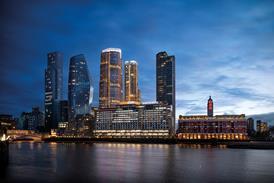There are plenty of contractors and consultants ready to claim that the project is on schedule, that the ┬Ż198m budget is holding and that the result will be a millennium experience to remember. Then there is a smaller group of dissenters who claim that the timetable is continually rewritten, there is little concept of a budget to stick to, and the end result could be an incoherent mishmash.
What is certain is that only nine months before the project is due to be completed, there is still doubt about the form and content of several of the 14 zones. A year after Tony Blair triumphantly launched the first details, it turns out that two zones have acquired new design teams, three others have been rethought with the help of additional architects and designers, and one ŌĆō Rest ŌĆō is drifting along without a designer at all.
The dome dissenters' main gripe is that, although individual zones may contain flashes of design brilliance and innovation, others will be condemned to mediocrity because of the lack of design time. "Some of the things I've seen are amazing, and some just aren't," one zone designer says bluntly. Also, some on the project believe there is little co-ordination between the various zone designers and little sense of a coherent whole being created under Richard Rogers' gigantic canopy.
But for every critic, there is a consultant or contractor genuinely thrilled to be working on one of the world's most prestigious projects. "You never appreciate what you've done until you have a chance to reflect. It'll take time to realise how significant it all is," says Mark Whitby of Whitby Bird & Partners.
"Working in the building industry is usually a little tried and tested, but here, we're in a high-tech world and we're really enjoying it," says Geoffrey Taylor, marketing director of steelwork fabricator Watsons.
The main concern seems to be what one of the doubters describes as the "incredible fluidity" of the decision-making process. "For quite a long time, there's been a variety of moves and changes," adds another.
One possible explanation for the changes is New Millennium Experience Company's chicken-and-egg problem of needing design work to attract sponsors, only to discover that the sponsor's expectations are not met by the completed design work.
For example, the Work and Learn zones ŌĆō sponsored by employment agency Manpower and Tesco respectively ŌĆō were in the hands of designer Park Avenue a year ago. But last summer, responsibility for them switched to design firm Work, designer of the Living Island zone. It was back to the drawing board again, and architect Allford Hall Monaghan and Morris was brought in later. Designer MUF has also been replaced on the Local zone.
Consultants working on the Serious Play zone say it too underwent a rethink last summer, after Sky switched its sponsorship to the external Baby Dome. Land Design's zone ŌĆō which features sponsor-friendly games of the future ŌĆō has still to sign up a financial backer. So far, NMEC has raised ┬Ż120m of its targeted ┬Ż150m in sponsorship.
The Rest zone is in a worse predicament, with no sponsor and no designer. Late last year, Park Avenue was progressing work on the domed structures of its theme park-style "dreamscape" ride for 16-seater beds. But the firm now says it is no longer working on the zone, and NMEC will only say that the zone's designer is "to be confirmed".
Some of those working inside the dome feel that NMEC content editors and project managers are struggling to get a grip on the project, and are reluctant to make decisions. "There's a degree of moving the goalposts.
A project is usually either flexible or fast-track ŌĆō to have the two in tandem makes it interesting," comments one designer wryly. He also claims that the zones will hit their deadlines, but only because "it depends which schedule you look at. They're continually being rewritten".
Tight programmes
Other designers express more neutrality.
"It's not always as easy as it might be. You have to get things sorted in the ground while you're changing things above ground," says one of the services engineers advising on the zones. "Generally, all the programmes are tighter than anyone would like from the point of view of an easy life," adds one structural engineer.
Up-and-coming subconsultants that have been drafted in to advise on the various zones are among the dome's strongest supporters. They include Tom Barker of design company DCA-b, who has worked on the Local zone's recycled cardboard tubes. He believes that several other innovative materials will be given a chance to prove themselves. "The legacy of the dome is as much about providing new opportunities in building materials as it is about the millennium and celebration," he says.
"It's a once-in-a-lifetime opportunity," comments Thomas Heatherwick, an artist involved in the design of the National Identity zone.
Throwing money at the problem
As construction progresses, one contractor feels that NMEC's 31 December deadline features far more heavily in negotiations than its ┬Ż198m fit-out budget, hence its willingness to "chuck" money at the project. "They made it pretty clear that time is paramount," he says.
However, that impression is not universal. One of the steelwork fabricators insists that NMEC has been "very commercial" in its dealings.
Inside the dome, the general atmosphere is described by one contractor as "controlled panic". The foundations for 11 of the 14 zones have been completed under the McAlpine/Laing joint venture. Installation of the steelwork for the central show is also nearing completion. McAlpine/Laing has set a target of completing the installation of the various zones' structural steelwork, and other "dust-making work" by the middle of the year.
Judging by the current state of affairs, the McAlpine/Laing manager in charge of the zones faces a tricky task. Steelwork packages do not appear to have been let for several of the zones, while the rest are at various stages, from starting detailed design to delivering the finished steelwork to site. At least half the zones are scheduled to start installation in April or May ŌĆō a period that promises heavy congestion inside the dome. One contractor conceded that this was a worry, but said: "We'll just have to ensure that everything's well engineered."
Work on the central show has brought to light an engineering design quirk in the dome. When the team examined the cable net structure beneath the membrane roof, it was discovered that its central point did not align with the central point on the ground.
As any structural engineer will confirm, the miscalculation does not mean that the dome is in danger of collapse. However, as the all-important deadline day approaches, NMEC will be hoping that the mistake does not have any superstitious significance.























